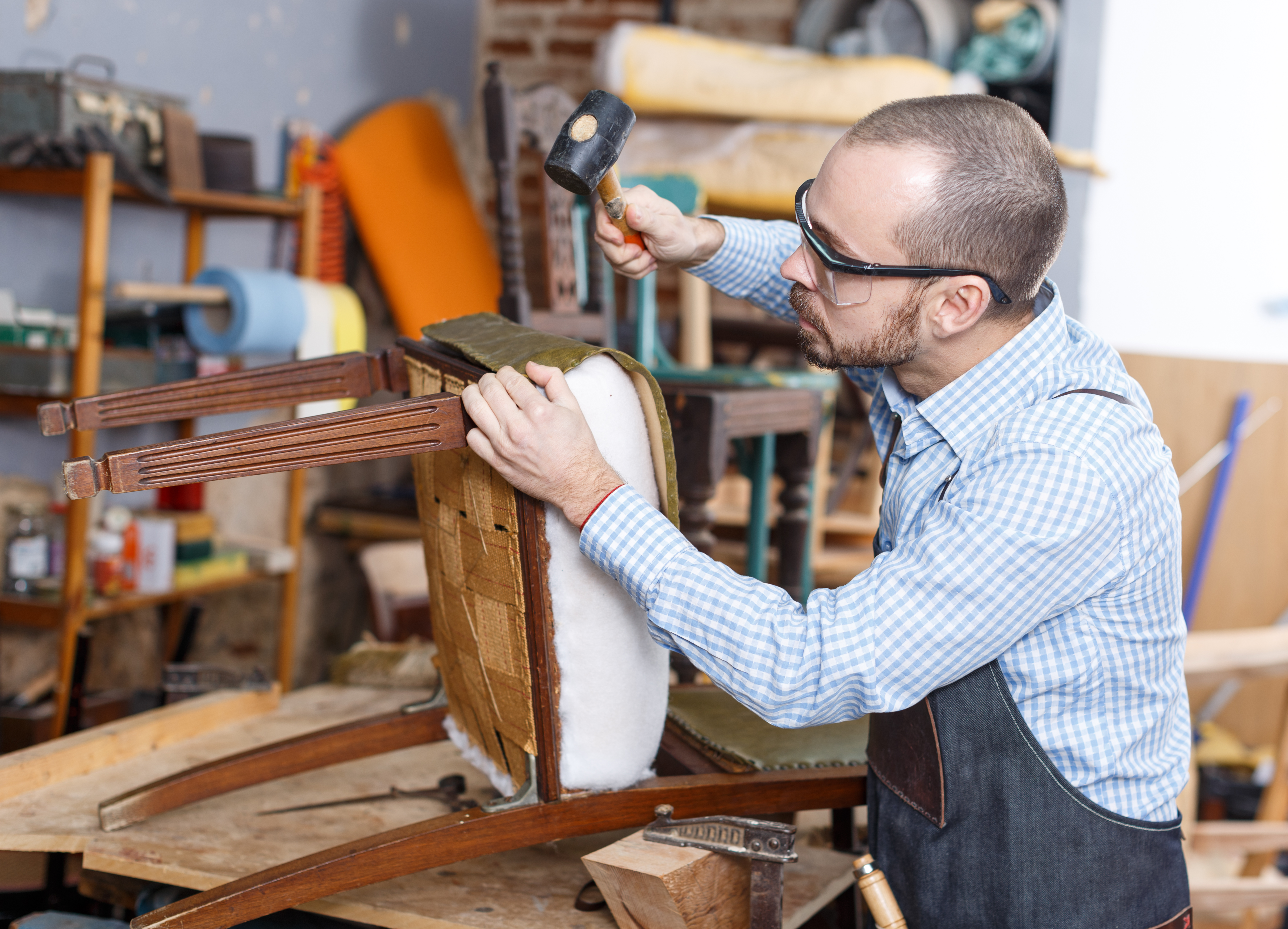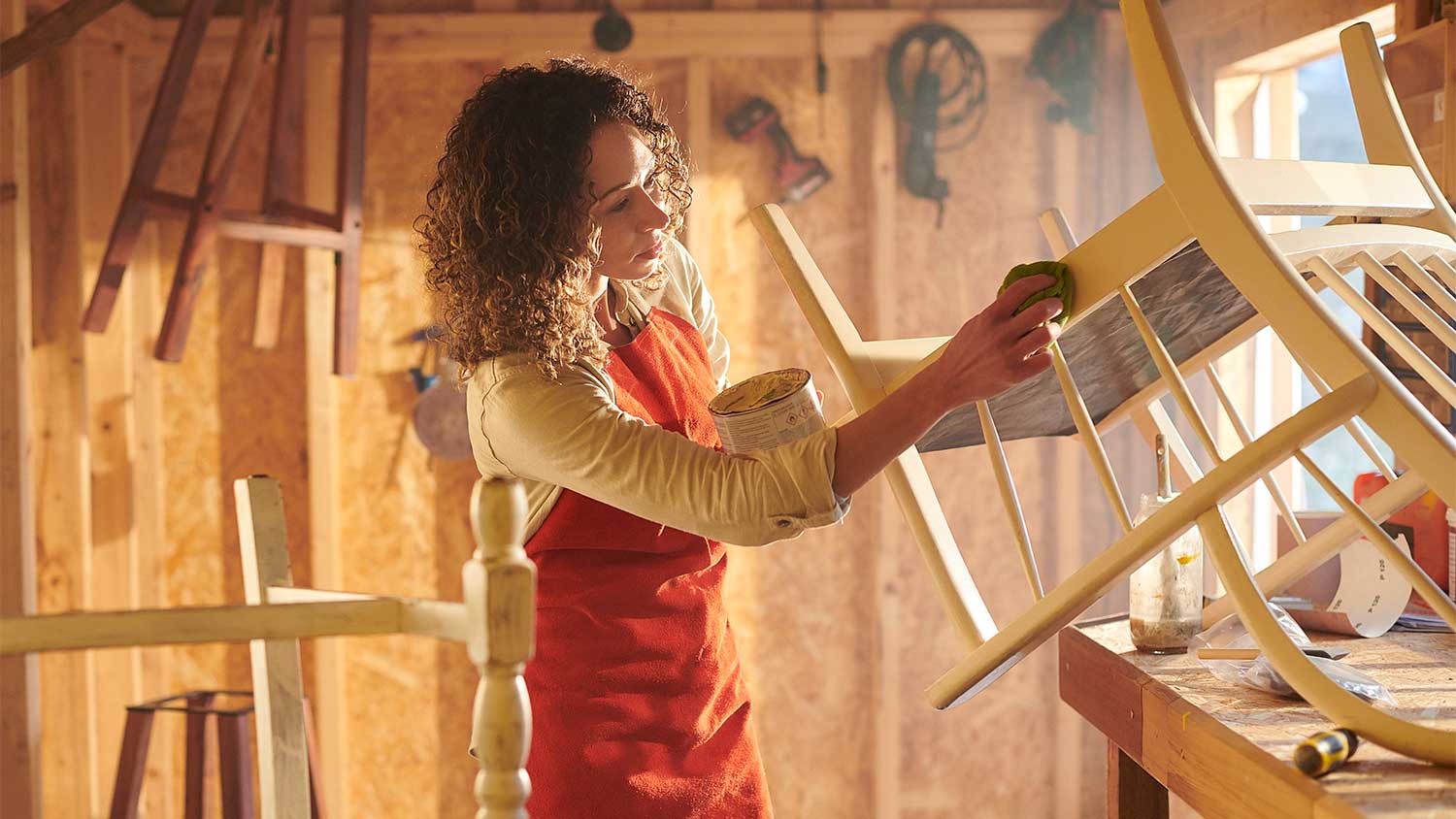
Discover the average furniture reupholstery cost, what impacts pricing, and how to save money on your next project. Get expert tips and cost breakdowns.
Not all old furniture needs the same kind of treatment


Replace furniture if repair costs exceed 50% of a new purchase.
Furniture restoration is ideal for making small repairs, like fixing scuffs or small tears.
Furniture refinishing is necessary if there is extensive damage.
When your favorite armchair begins to falter, or your grandma’s antique end table starts to wobble, the question of whether to restore or refinish furniture will surely pop up. These two repair methods may sound similar but have some key differences. Your chosen method depends on just how damaged a piece is and how much of a change you want to make.
Refinishing involves removing and replacing an old finish with a new one, while restoring furniture consists of making small repairs, like tightening a loose leg or buffing out a light scratch. So, which route should you take? This guide will help you figure that out.

Before we can discuss whether to restore or refinish furniture, you have to decide if it’s worth repairing in the first place. In general, making repairs should be a budget-friendly option, so you may be better off buying new furniture if the cost to mend is 50% or more of the cost to replace.
| Repair | Replace |
|---|---|
| Only has light damage | Damage is beyond repair |
| It’s a family heirloom with high personal value | If the cost to repair is 50% or more of the cost to replace |
| It’s a rare, designer piece | If you didn’t spend much on it to begin with |
Furniture comes in all shapes and sizes, and each unique piece requires different kinds of care.
For instance, reupholstering an armchair or sofa requires extensive and costly craftsmanship. On the flip side, an old wood table may need to be completely refinished but would be overall more affordable to repair because it’s made of just one material and is easier to DIY.
The age of your furniture also plays a part in whether you should repair or replace it. If something has been passed down for generations, you may be unwilling to part with it even if fixing it costs a lot. However, you’d be better off replacing old furniture that doesn’t have sentimental value because it’s at the end of its useful life.
When developing a budget, keep in mind that you’ll spend more to refinish than restore—especially on furniture reupholstery costs. What you spend to repair an object should be less than half of what it would cost to replace it. But that rule does not apply when talking about objects with personal value—like a family heirloom or rare and designer finds.
How long a piece of furniture lasts will depend on its type, the material it’s made from, and how it was designed.
Metal objects can last up to 50 years or more with only occasional maintenance. Wood furnishings will need more care, but their life spans can extend beyond the century mark. Fabric items will start to degrade between 15 and 20 years after purchase. Of course, a piece that was poorly designed may cave in much sooner, regardless of the material it was made from.

Restoring furniture is less expensive than refinishing because it requires fewer materials, is easier to DIY, and isn’t as extensive. Plus: refinishing an object without the right skills could damage it irreparably, so you may need to spend even more to hire a furniture restoration pro near you to ensure the job is done properly.
The cost to refinish a piece of furniture, including labor and materials, can range anywhere from $150 to $1,500, whereas furniture restoration can be as little as $35 for certain projects, and up to $500 on average.
Here are all the instances when restoring furniture is the way to go.
Let’s say your table is scuffed, or one of the legs is loose. Or maybe a fluffy armchair has one small, hardly noticeable tear that could become a gaping hole if not attended to ASAP. Restoration is the right pick in all of these instances. It will usually involve simple tasks like buffing out marks and dents with oil or making small stitches, all of which won’t break the bank but will make your furniture look as good as new.
Refinishing an object involves stripping away and replacing old finishes, which can impact its appearance. This method may not be right for an object that you love for its antique appearance. Restoration allows you to fix it up without drastically altering how it looks.
Because furniture restoration doesn’t involve a ton of advanced techniques or require professional tools and equipment, it’s relatively easy and cost-effective to do it yourself. But if you doubt your abilities, and don’t want to risk damaging an object further, hiring a pro will guarantee that doesn’t happen.
Objects that are highly damaged, or thrift store finds that could use a modern update, are all great moments to consider refinishing over restoring furniture.
If the finish is peeling, there are dents and scuffs everywhere, and an object appears to be moments away from caving in, refinishing it is the only way to guarantee it’ll be usable in the future. This is especially true for reupholstering fabric pieces, which may be unsuitable for use without the touch of a pro.
Maybe you found a piece at the thrift store that doesn’t fit your current vision but could use a complete makeover. This is another instance when refinishing will deliver the right results—and a good opportunity to train your DIY skills since you probably didn’t spend too much on the item to begin with.
Whether you DIY or hire a pro for a project like this will depend mainly on the value of your furniture. If it’s a family heirloom that you’d rather not risk damaging, an expert will ensure it stays safe during the process. But if you’re revamping a flea market find that didn’t cost a lot, going the DIY route is a low-stakes way to improve your skills.
From average costs to expert advice, get all the answers you need to get your job done.

Discover the average furniture reupholstery cost, what impacts pricing, and how to save money on your next project. Get expert tips and cost breakdowns.

Wondering how much it costs to refinish a table? Get average prices, cost factors, and tips to help you budget and choose between DIY or hiring a pro.

Discover average furniture repair cost, key price factors, and ways to save. Get expert tips to budget for your next furniture repair project.

Explore Murphy bed installation costs, including average prices, key cost factors, and tips to save. Learn what impacts your project budget and make informed decisions.

Wondering how much it costs to reupholster a chair? Learn about average prices, key cost factors, and ways to save on your chair reupholstery project.

Discover custom furniture costs, including average prices, cost factors, and tips to help you budget for your next custom piece.